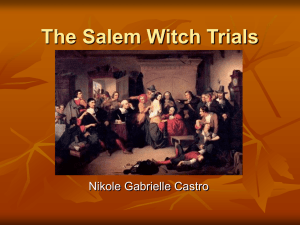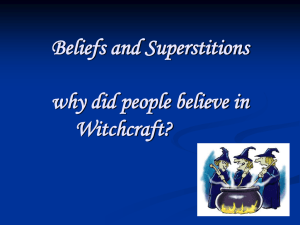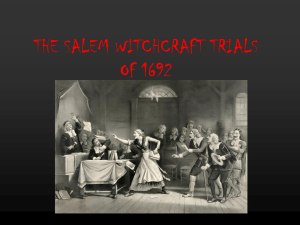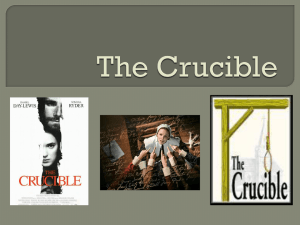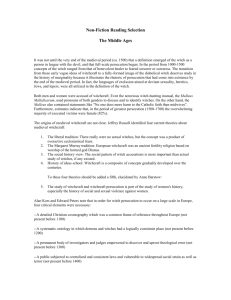The Salem Witch Trials & The Crucible
advertisement
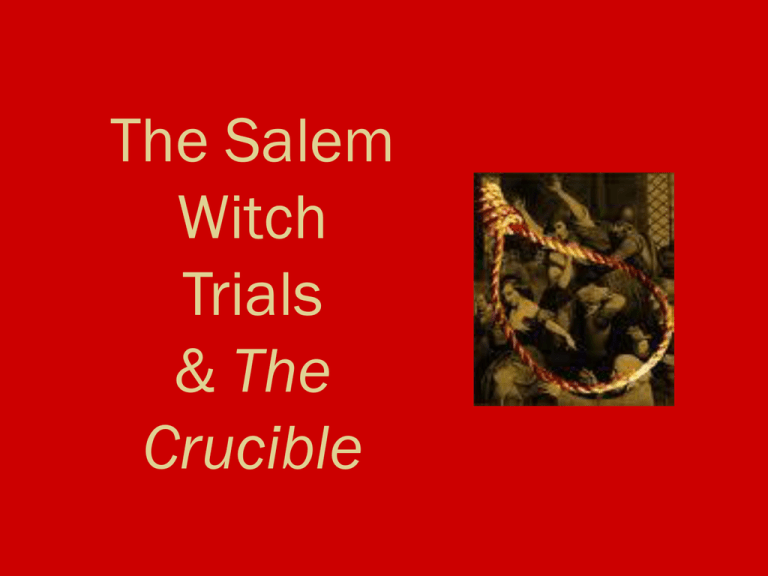
The Salem Witch Trials & The Crucible Daily Life in Salem, Massachusetts • 550 people, 90 houses, 20 square miles • Most people were poor & uneducated • Most families had to support themselves: making their own clothes, planting vegetables, raising meat • Farming was often a painstaking task in the harsh climate and rough, rocky terrain • Endured many trials and • tribulations: – – – – – cold winters, disease insect infestations fires pirate & Indian attacks Belief in the Devil/Witches • People saw the Devil lurking behind every misfortune • Believed that the Devil was a real, live enemy • Believed the Devil’s helpers were witches • Believed that their hardships were the work of the Devil as a punishment from God • Witchcraft was a believable occurrence • Witchcraft was a felony and punishable by death Salem’s Religion • • • • • • Most people were Puritans – Members of a religious group who left England to escape religious persecution Believed in predestination or “fate” Believed if sinners asked for forgiveness that they would be forgiven Believed all people were born sinful Men & women sat on opposite sides of church ALL daily activities were dictated by the Church Behaviors and Beliefs • • • • • • • Believed that Puritanism was the “right” and only way to live Believed sickness and failed crops were a sign of God and, therefore, would not help their fellow men Had to wear dark colors/plain clothing at all times Children were always expected to behave as adults Children did not “play” since toys & games were seen as sinful distractions All signs of emotion for all ages were punished Most were illiterate but those who did learn to read only read the Bible or other religious works Salem Government & Laws • • • • • America was still under British rule/laws Salem was theocracy (combined church & state power) which meant religion could overtake government In order to be a judge and determine the fate of “criminals,” one did NOT need any legal background whatsoever Against the law to NOT attend church Falling asleep in church or stealing food were punishable in the same way The Salem Witch Trials • • In 1692, 24 innocent people were killed after being accused of witchcraft and over 150 were jailed in Salem, Massachusetts There was no “real” evidence against witches, only “spectral” evidence which could be made up by anyone – – • • A “Spectre” is the active agent of a live witch who could toture live humans A ghost is the active agent of a dead person People accused their neighbors, most often for personal suspicion, gain, or just plain hatred Continued because a “domino effect” occurred where those who were accused began to accuse others Witch Accusations • Witch accusations spread all across the Massachusetts Bay area • Those accused of witchcraft and killed could not be buried in religious cemeteries • By 1693, it was recognized that the events of the Salem Witch Trials were wrong • There were witchcraft accusations in America well into the 1700s (especially women, kids, the insane) What is a Witch? • Definitions – – – A person who made a pact with the Devil (traded his/her soul for special evil powers in which to torment others) Those who practiced Wicca, a religion that is based on nature The modern witch who wears a black hat, has a black cat (and sometimes a wart on her face), and flies on a broom How Does One “Prove” Witchcraft? • Witch “Tests” – – – • Swim test: victims were tied up and thrown into a lake…if they sank, they were NOT witches, but drowned. If they floated they were witches and killed anyway Trick knife: a trick knife was used to “stab” the victims, if they didn’t bleed (which they wouldn’t), they were witches Witchcake: a “cake” was made with flour and the accused’s urine and fed to an animal, if the animal exhibited strange behavior, the accused was a witch Confession: if the accused confessed (usually under torture), it was used as evidence against that person Punishment • • In America, accused witches were hanged In Europe, accused witches were burned at the stake The Crucible • A play written by Arthur Miller • Published in 1953 • Written during a “modern-day witch hunt” – McCarthyism & The “Red Scare”-a search within America for Communists • Themes: Social & economic pressures The Crucible vs. Salem • Differences – – • • The Crucible is BASED on the Salem Witch Trials and 1692 Salem It is not completely historically accurate Most events did occur and many characters did actually exist The Crucible is NOT a historical account of the Salem Witch Trials

